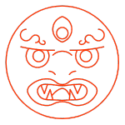virtual museum
East Asian Esotericism in the Pre-1950s
The next four illustrations were extracted from『一人で出来る健康法』(Health Practices One Can Do By Oneself), compiled by Ishiguro Kensuke 石黒憲輔 and published by Ōsakayagō-shoten in 1929.
This manual collected many of the self-cultivation techniques popular in early twentieth-century Japan. The man in military attire is Kaetsu Satoshi 嘉悦敏 (1870–1944), a high ranked officer and also adept at psycho-spiritual therapies (seishin ryōhō).
Kaetsu’s interest in psycho-spiritual healing illustrates the enormous popularity of such methods amongst military officers in Japan and China at that time.




The next three drawings were extracted from Mesmer, F. A. メスマー (auth.), Suzuki Manjirō (trans.) 鈴木万次郎訳 (1885), Dōbutsu denki gairon 動物電気概論 (Introduction to Animal Magnetism) Tokyo: Iwafuji Jōtarō. The exact year when Animal Magnetism (Mesmerism) was introduced to Japan is not clear, but this is the first known book dealing with the technique.
Although Mesmer is credited as the original author, this is a Japanese translation of writings by the American mesmerist, John Bovee Dods (1795–1872).



The next two illustrations comprise the covers of the 心靈 (The Spirit), a periodical published by the Chinese Institute of Mentalism (中國心靈研究會) between 1913 and the late 1930s.
Inspired by similar groups flourishing in the West and Japan, the Institute stood as one of the largest and most active Chinese associations involved with spiritualism, psychology and psychical research.





The next three photographs are related to Taireidō (大霊道, lit. The Way of Great Spirit), the largest organisation of psycho-spiritual therapies (seishin ryōhō) in twentieth-century Japan, particularly active from the mid-1910s to the end of the 1920s.
Taireidō’s theory posits the existence of reishi (spirit-particles) in each individual and a tairei (great spirit) in the universe. A reishi is an entity beyond mental and physical phenomena, so being able to control it would allow one to carry out physical and mental healing.
Taireidō had an enormous impact in Republican China and played a fundamental role in the development of Spiritual Science therein.



The next three illustrations were extracted from『耳根円通法秘録』(The Liberation of the Body and Mind: The Secret of the Method of Cultivating the Ear Roots), compiled by Kihara Tsūtoku 木原通徳 in 1918.
This is an early-twentieth-century technique for self-cultivation inspired by Buddhist meditative methods recorded in the Śūraṅgama Sūtra (大佛頂首楞嚴經).



